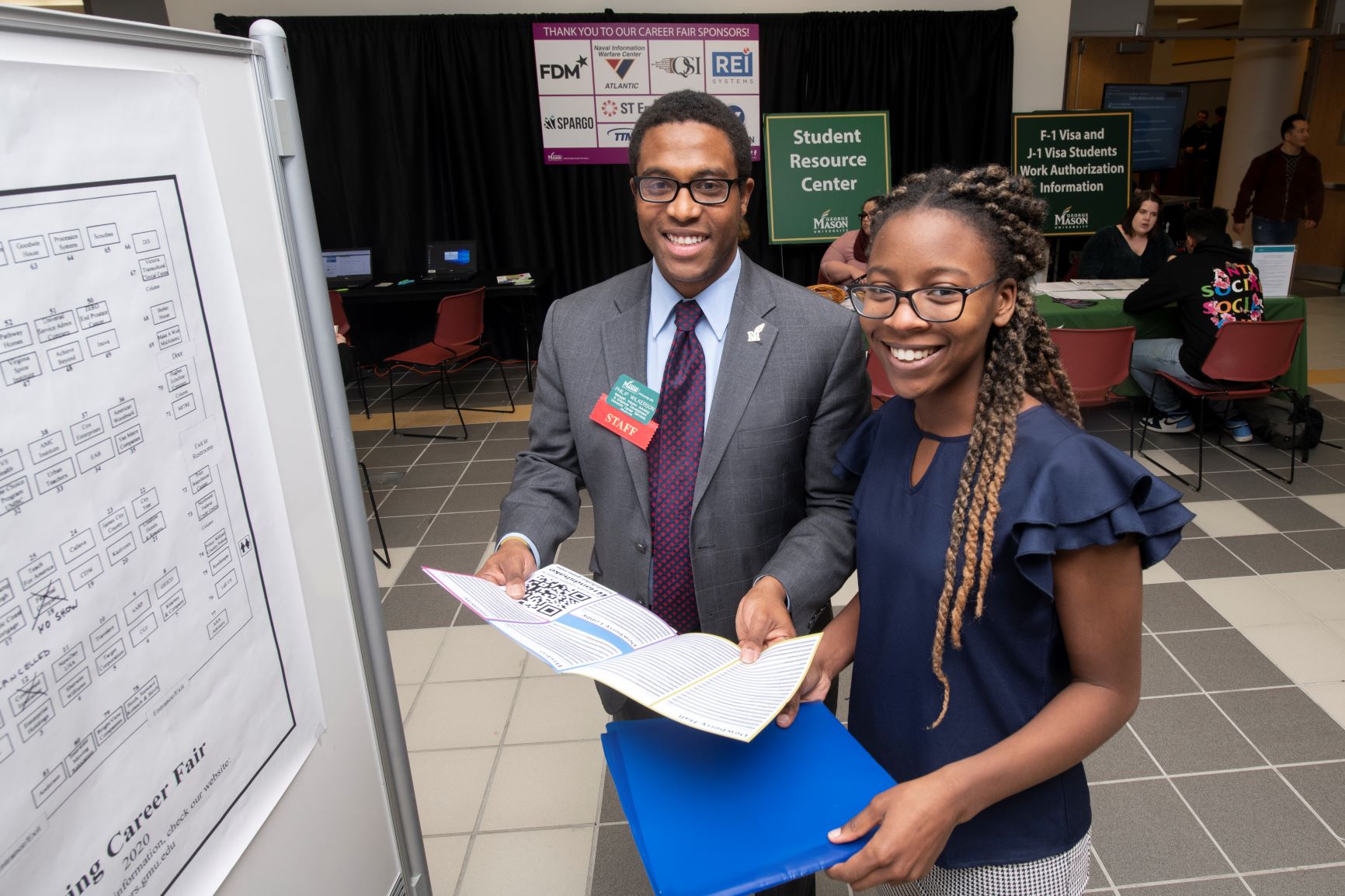By: Zara Saemi, a Mason student majoring in Psychology, Honors College student, Student Government senator, Mental Health and Well-Being Task Force student liason
“Is there another way to judge potential? NASA thought so. When they were soliciting applications for astronauts, they rejected people with pure histories of success and instead selected people who had had significant failures and bounced back from them.” – Carol Dweck
How do you set your goals and measure your success? Do you think you’re stuck with a fixed amount of potential, or do you believe it’s possible to improve your abilities through dedication and hard work? Your mindset about your potential impacts both your success and your well-being. A growth mindset can unlock great potential in your life. Here’s how to develop a growth mindset.
What is a growth mindset? According to this Psychology Today blog, “A growth mindset, as conceived by Stanford psychologist Carol Dweck and colleagues, is the belief that a person’s capacities and talents can be improved over time.” This mindset is the opposite of a fixed mindset, which tells you your abilities are limited. Learn about the differences between fixed and growth mindsets in this Harvard Business School online article. Unlike a fixed mindset, a growth mindset highlights the hope of a better future. Developing a growth mindset empowers you to work to improve your abilities.
How a Growth Mindset Can Improve Well-Being
People with a growth mindset showed healthier scores than others on mental health scales like SCL-90 and ASLEC. That was possibly because they approached self-report questionnaires with a mindset of continuous learning and improvement. They tended to underestimate their symptoms, demonstrating a more cautious and focused attitude than other people did. College students with a growth mindset displayed better adaptability and coping mechanisms when facing challenges – including academic stress – this research study from Huzhou University and McMaster University showed. They viewed mistakes as learning opportunities, stayed focused during challenges, and were more likely to take initiative and derive strategies to adjust their thoughts and goals. The growth mindset group employed more positive coping strategies, such as analyzing reasons for failure and believing in the potential for improvement through effort. In contrast, those with a fixed mindset often resort to negative coping mechanisms like making excuses for failures, hindering their own development.
Overall, individuals with a growth mindset demonstrated better mental health, adaptability, and coping strategies compared to those with a fixed mindset. They embraced challenges as opportunities for growth and approached life events with a more positive outlook.
How I Developed a Growth Mindset
My odyssey of breaking free from the clutches of a fixed mindset and embracing a growth mindset has been both tumultuous and illuminating. The story begins in a small town far removed from the bustling streets of the United States. In those serene surroundings, I navigated life with familiarity and comfort. However, the trajectory of my existence veered dramatically when I embarked on a journey to a new land, culture, and way of life. The transition was anything but seamless.
Arriving in the United States during my formative teenage years, I found myself thrust into an unfamiliar environment, where every face seemed to radiate competence and capability. That left me feeling like a mere bystander in my own life. The halls of my high school echoed with the laughter and camaraderie of peers who shared experiences foreign to me. As I struggled to bridge the chasm between us, a sense of inadequacy took root within me, blossoming into a suffocating cloud of depression and anxiety.
In the crucible of college applications, I faced my greatest adversary: the blank canvas upon which I was to paint the portrait of my identity. Yet, my palette was stained with the hues of hardship and struggle, rendering it challenging to craft a narrative that spoke to the resilience buried beneath the surface. It was in the middle of this turmoil that I first glimpsed the shadows of a fixed mindset looming over me. I grappled with a sense of urgency and perfectionism that only served to deepen the trenches of my despair. Each day became a battleground, with self-doubt and fear as my adversaries and the elusive promise of a better future as my prize.
Regret thrives on hindsight. An emotional debt and seeing unclearly what I should have done in the past. It is natural to create a coherent narrative with my present reality. I acted out of self-preservation. When I look back, I have some regrets. The regrets come from my inaction and lack of decision. I was waiting for a sign. I was not choosing a path because I was unsure what to choose. I decided not to take any action at all. My fixed mindset creeps up on me sometimes, waiting to be ready or telling myself that I am just patient for the right moment, which never comes. I was unable to thrive. Waiting and wishful thinking were not my best decisions. It only persisted in my perfectionism and self-doubt and caused a breeding ground for a paralyzing regret. Hindsight showed me no choice was itself a choice. It was choosing life happening to me instead of allowing life to happen for me. I let circumstances construct my fixed mindset. Of course, self-doubt was a preservation tactic, because I thought it would protect me from unwanted consequences. I overestimated the consequences in my head and potential failure.
But in the chaos, a flicker of realization ignited within me. I understood that the lens through which I viewed the world was not immutable. It was a choice – a narrative I held the power to rewrite. So, I embarked on a journey of self-discovery, peeling back the layers of my fixed mindset to uncover the seeds of growth lying dormant within my mind.
It was not a journey marked by cliché platitudes or easy victories. Instead, it was a gritty, relentless pursuit of self-awareness and self-compassion. I realized life was about trade-offs. I prefer to act and possibly fail instead of being passive toward my own life and regretting that.
Today, I carry the wisdom I learned with me. I understand that mindset is not just a lens through which we view the world but a compass that guides our actions and shapes our reality. By cultivating a growth mindset, we unlock the door to a future brimming with potential and possibility. I advocate setting intentional steps that balance mindfulness and spontaneity and bring more joy and depth into my life. A growth mindset trades off comfort with experiences. The antidote to indecision is not an impulse action but an intentional, actionable step. Waiting for the perfect moment is a myth. We must learn to get ready by doing more.
How You Can Develop a Growth Mindset
A growth mindset can give you clear, actionable steps. It frees you from worrying about trying to achieve perfection and helps you welcome life’s challenges as valuable learning opportunities. Abilities can change and evolve with the process of learning and taking on more challenges. So, don’t avoid challenges, but welcome them into your life as opportunities to learn and grow. Look beyond your abilities right now and believe that you can improve your abilities in the future. Get excited about learning and decide to become a lifelong learner. Darwin Smith of the Kimberly-Clark Corporation has said about lifelong learning: “I never stopped trying to be qualified for the job.”
Also, don’t make decisions based on your ego. People with a fixed mindset seek perfection and quick gratification to fulfill their egos. Don’t worry about trying to feed your ego. Instead, try to feed your well-being. Make the choices that will help you thrive, both personally and professionally.
Finally, a simple yet powerful practice known as “reframing” involves consciously shifting your perspective on challenges, setbacks, and self-perceptions to align more closely with a growth mindset. You can reframe your fixed mindset thoughts into statements that reflect a growth mindset. For example, instead of saying, “I’m not good at this,” you could reframe it as, “I haven’t mastered this yet, but with practice and effort, I can improve.” Shift your focus from seeking validation or avoiding failure to embracing challenges as opportunities for learning and growth. Instead of fearing mistakes, see them as valuable feedback that can help you improve. Take time to reflect on your progress and the impact of reframing your mindset. Notice any positive changes in your attitude, behavior, and resilience when facing challenges.
By consistently practicing reframing, you can gradually shift your mindset toward a more growth-oriented perspective. That can lead you to increased resilience, motivation, and overall well-being. Be fully present with a compass in mind to stay focused on your growth. Evaluate your actions and choices that guide you so you can thrive more in life.
Additional Resources
- The TED Talk ”The Power of Believing That You Can Improve” by mindset researcher Carol Dweck
- The website MindsetWorks
- The article “What Is a Mindset and Why It Matters” by Kendra Cherry
- The podcast “The Science of Success Mindset” by Lewis Howes with Andrew Huberman
- “Growth Mindset” activities by Khan Academy
Write one of these Thriving Together Series features! We’re looking for contributions on all topics related to well-being. Read other Thriving Together Series articles here and contact us at cwb@gmu.edu for guidelines. Thank you for helping our Mason community thrive together online!






















